
Science in Hinduism-Theory of perception
When we hear about theory of perception, then usually all the scientific theories and experiments of human brain, eye and senses comes into picture. We normally credit theory of perception to modern science but what we are unaware is that this theory of perception was mentioned multiple times by Indian sages thousands of years ago.
If you are not a science student than most probably you may not be aware of theory of perception. So, I will be a giving a small explanation on theory of perception as per modern science and then I will compare this modern scientific theory with theories of Indian sages, written thousands of years ago.
Theory of perception according to modern science
Our eye is an organ only to see, not to understand what it sees. Our eyes only see light rays in an object. These light rays are converted into electrical signals by neurons. When this electrical signal reaches our brain, it visualizes the object or matter. Scientifically, these electrical signals pass through optics tract and optic thalamus to the centre of vision in the occipital lobe of the brain which lies to the back of the head. In the occipital lobe, a positive image of the object is formed. So, whatever we see is the interpretation of the mind. It is our brain that perceives an object and not the eye. Our eyes only see light rays in an object whereas our brain perceives what the object really is.
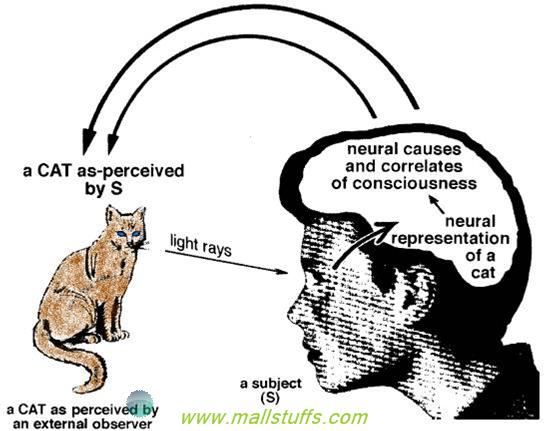
Modern Theory of perception
The green color of the leaves is due to vibiration of light at a rate of 10 millions per seconds. When these light vibrations strike the retina, objects are perceived in a particular form and shape by the brain. Similarly, our ears only hear the sound. It’s our brain which decodes the vibration of sound into something more meaningful to us. So everything that happens to us is the interpretation of the mind. It is our brain that shows us this virtual reality and an illusioned world.
The above functioning of human brain is summarized in the Upanishad verse as
"When one thinks, then he understands; without having thought, one does not know; it is only after having thought that one understands."
(Chhandogya Upanishad, VII-xxi-1)
Perception According To Sankhya Philosophy
Sankhya philosophy is similar to Vedic philosophy. According to this philosophy, our eyes are an external instrument (Karanas) for perception. The real organ of vision is situated in the brain and so, is the case with all other senses. This is confirmed by science which says the real auditory, visual, gustatory, tactile and olfactory centers are in the brain and in the astral body. These centres are the real senses which make perception possible. Through Indriyas(Senses), Mind is connected with all the physical organs of the body. Inside the brain, there is a center for each organs of the body.

Centers of various senses in the brain
Indriyas carries the sensation to buddhi(Brain) and the buddhi presents the sensation to Purusha(soul) and it’s the soul that realizes the other soul(object) and sends the judgments to the (Buddhi)brain. Buddhi receives these judgments and then do proper analysis after taking into consideration all the pros and cons of the subject before ordering the senses to execute the physical organs for appropriate action.
As a real life example, suppose you see a friend, then the senses in the eye sends brain the light rays seen in the object (friend), brain sends this information to the soul (spirit), soul recognizes the other soul (Friend) and sends the information to the brain. Brain then looks into its memory to validate the information sent by soul (whether he is really friend, his past experiences etc). Then, it analyses the situation (Pros and cons) outside and then directs the physical organs to take appropriate action. By situation and action, I mean if the friend is situated far away, then brain will direct your physical organs to say hi(eyes will be wide, face will be smiling , hands will be oscillating, legs moving towards your friend etc). If the friend is situated very near, then the brain will direct your physical organs in a different way(Hug your friend, close your eyes, greet him etc). The situation would be very different if you see an enemy in case of a friend because the brain will direct your physical organs in the other way around.
Sankhya philosophy believes brain to be the prime minister whiles the soul to be the judge. Indriyas(senses) are the advocates which brings statements to the judge(Soul) and buddhi(Brain). Indriyas also acts as the commander in chief that receives order from the buddhi and passes on the order for execution to the soldiers (physical organs). What an excellent theory of perception according to the Sankhya Philosophy.
The Advaita Theory of perception
According to Advaitic theory, it is the Chaitanya(Consciousness) within us that makes perception possible. Chetana(Consciousness) within us unites with the Chetana(Consciousness) of the Vishaya(object) and the end result is perception. Does it mean that the mind and senses are useless entities? No, the senses are necessary for the exact perception of approximating things.
According to this theory, Buddhi(mind) interact with eye to assume the shape of the object outside. When the eyes open, Antahkarana-Vritti(Change in state of human mind) makes the mind to enter into the opening of the Indriya (eye) and assume Vishayakara (the form and shape of the object), thereby enabling you to view the object. Antahkarana-Vritti causes Avarana-Bhanga (removal of the layer of Sthula Avidya that envelops all objects).
Instead the light rays of the object reaching the brain, ray of light from the brain goes out to the object, assumes the shape & form of the object and then, the real perception takes place. Television is perceived only when the brain has assumed it in the form and shape of a television. Whatever the light you see in the object outside has their images in the mind inside.
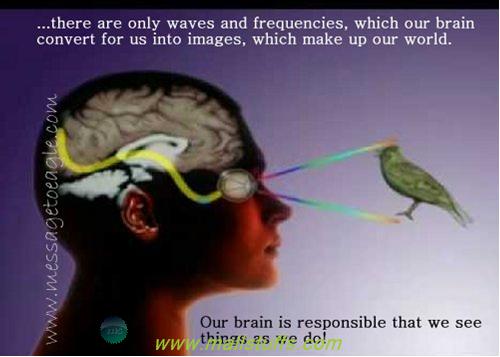
Rays of light reaches the object and an image is formed
Below illustration from the Vedanta-paribhasha explains this theory of perception: ‘As water from a tank may flow through a channel into a plot of land and assume its shape (square, triangular or any other form), so the radiant mind (Taijasa-Antahkarana) goes out through the eye or any other sense-organ to the place where an object is, and gets transformed into the shape of that object. This modification of the mind-stuff is called a Vritti’” (Practice of Yoga: Vol. I, pp. 107-108).
In an apple garden, a ray from the eye goes outside to assume the shape of an apple. This ray is called as Vritti. The visualizing process is called as Vritti-Vyapti. Vritti opens the Avarana(Veil) that envelops the apple and the Chaitanya(Consciousness) associated with this Vritti illuminates the object ‘apple’. This process is called as Phala-Vyapti. Like the torch illuminates the object, this Vritti-Chaitanya illumines the object which makes the perception possible. Range of vritti is limited and hence our eye has limited perception. Mind Creates Sankalpa-Vikalpa(Confusion) like: Is this a apple or not? Buddhi comes to rescue by determining the object through past experiences. After the perception, many senses come into picture. Chitta(mental condition) makes Anusandhana (enquiry): "How to get this apple?” Ahankara (Ego) asserts: "I want the mango anyhow" and so on
Apple tree is the mental precept and a mental concept. You know the existence of apple tree only through your mind because there exists a mental image in the mind. Image in the mind plus external light is the object (apple tree). I mean even when you close your eyes, you can still see the image of apple tree through memory.
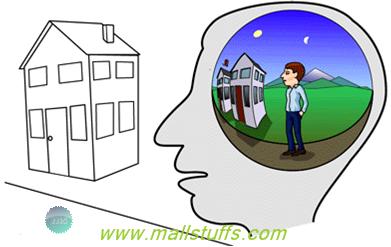
Image of house inside the brain
Similarly your body is external to you and is a mental concept. You are what your soul is. Apple tree is external to you from the standpoint of your body; your body is external to you from the standpoint of your soul. Also, there is nothing internal to you. Because when the externality goes away, what is the existence of internality? Both the terms externality and internality are creations or illusions of the mind. Only thing that exists is your soul (Atma) and its relation with the divine soul (Parmatma) which we better call as god.
When you were born, you didn’t know anything. Slowly and slowly, you started nesting the image of the light vibrations (object) in your memory (Brain). Similarly, you didn’t knew any language but slowly and slowly, you started inserting sound vibrations in your memory and today, when you hear something, your brain associate it with a particular meaning or object. If you hear any new words, you add it up in your memory along with its meaning.
From above, we can say that there is nothing good or bad. It is the mind that creates good or bad. No words are ugly. It is the mind that associates words as good or bad.
Vedic Theory of Perception
According to Vedas, mind is very elastic. Mind becomes elastic when objects come in contact with the various Indriyas(sense organs) of your body. Your mind starts coordinating with the sense of the body. There are different compartments in the brain, each compartment responding to one of the sense organs of the body. Ours state of mind is called as “Drishti-Srishti-Vada”, which means the perceiver and the object perceived are one and the same. Confused? Here is the analogy: Just like the spider spins his own web from his own body, our mind projects the physical universe from our own body. This physical universe is projected till the mind is awake and then taken back when the mind goes to sleep. This process is repeated everyday and this changing state of human mind is called Vritti.
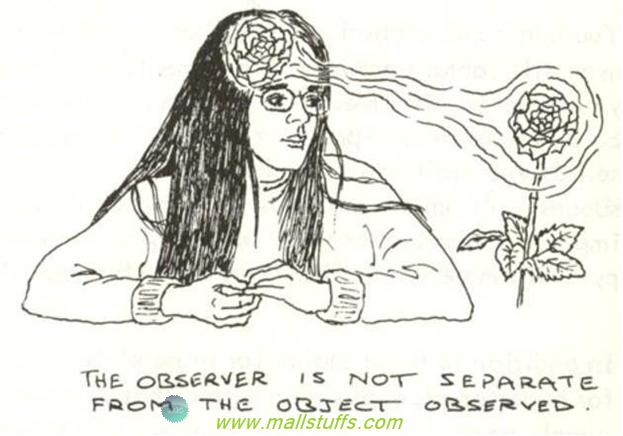
I guess this also explain the creation aspect of our universe where lord Brahma projects this virtual world in his awake state and destroy this universe once he goes to sleep. The only difference is his awaking time is in billion human years followed by the same sleeping time.
Drishya (what you see outside) is the result of mental Avidya(perception/deception). There is only vibration outside. There is only light outside. It is the mind deception that produces shape and color to the object. Interaction of the mind with the vibration outside is the object you see is the virtual world.
Hinduism says our body is made of five Tattva (elements): Agni (Fire), Jal(Water), Vayu(air), Bhoomi(Earth) and Akash(Ether).
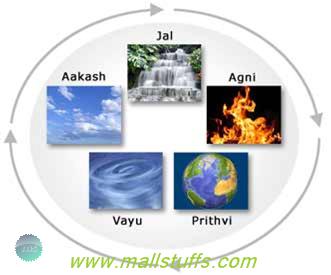
Five elements of nature
Our brain is formed of all these five elements but the eye is made of Agni-Tattva (Fire) alone. So, our eye can see only fire. As said before, there is only light outside in the virtual world and since our eye is formed of fire, our eye sees this light (light is form of fire). Ex: Light emitted by sun is nothing but fire. Since our mind is made of all five elements, Agni tattva of mind interacts with eye and then the mind uses other tattvas(elements) to visualize the object(light) seen by eye. Similarly, sound is a form of Akash(Ether) tattva and our ears are made of Akash tattva. So ears hear sound then mind uses its Akash tattva to interact with ears and then synchronizes it with other tattvas to understand the sound. On the same lines, Atma(soul) can see hear, taste, feel everything and this atma(Soul) can be seen by atma only. Therefore, all the living entities outside is Atma(Soul) only. "Sarvam Khalvidam Brahma” meaning “Everything is verily Brahman”.
Mental Cognition Takes Place Serially
Mind is Niravayava (without divisions, parts, compartments). It can respond to only one idea or object at a time though it has the marvelous speed of switching from one idea to another or from one object to another. These marvelous speeds of responding to ideas holds out the conception that mind can multi-task several ideas at a time. Mind is actually a guard that will allow only one object, senses or idea to reach brain at one time. Seeing and hearing doesn’t happen at the same time.

Ideas from different sources reaching one at a time
Cognition or perception through our mind takes place serially and not simultaneously. Simultaneous perception is possible only for enlightened yogis. Simultaneous perception is actually a boon acquired by eons of meditation and yoga. Our finite mind cannot hold two ideas at a time no matter how much the idea are related to each other. Our unconsciousness and nature of internal organs prevents us from viewing two or more object at a time. Your organs may come in contact with multiple objects at a time but our gatekeeper(Mind) will allow to respond to only one at a time.
When your mind gives full attention to see, then you can only see and cannot hear. For Ex: When you have concentrated your mind in reading a book then even if a man shouts, you will not hear it. It is only when your mind gets deflected to the events occurring outside, your mind respond to that event. When you think of a serious problem, your mind cannot see nor hear nor feel until the mind is deflected.
Below is the verse from the Upanishad with the same meaning
"My mind was elsewhere, I did not see; my mind was elsewhere, I did not hear, for man sees with his mind and hears with his mind." Brihadaranyaka Upanishad, I-v-3).
Even the western philosophers, scientists and priests agree to this single idea theory that the mind cannot respond to more than one idea at a single instant of time.
Intuition Theory of Perception
Intuition is also the way of perception. By intuition, your mind can perceive the hidden truth of the events happening around you. Intuition is also called as eye of wisdom through which you sense, induce and deduce conclusion of the unknown event. Intuition is the Prajna-Chakshus, Divya-chakshus, or the Jnana-chakshus through which the yogi or sage perceives the absolute truth of the all-pervading God. Without intuition, an intellectual man remains imperfect of the truth behind appearance of the problem. Sometimes, the intuition is the inspirational force behind your motive or aim. While intellect gives you a partial knowledge from reality, Intuition gives you an entire insight to reality. Intuition is the voice of the soul, the source for apprehending eternity. Intuition is the solution to your problem.
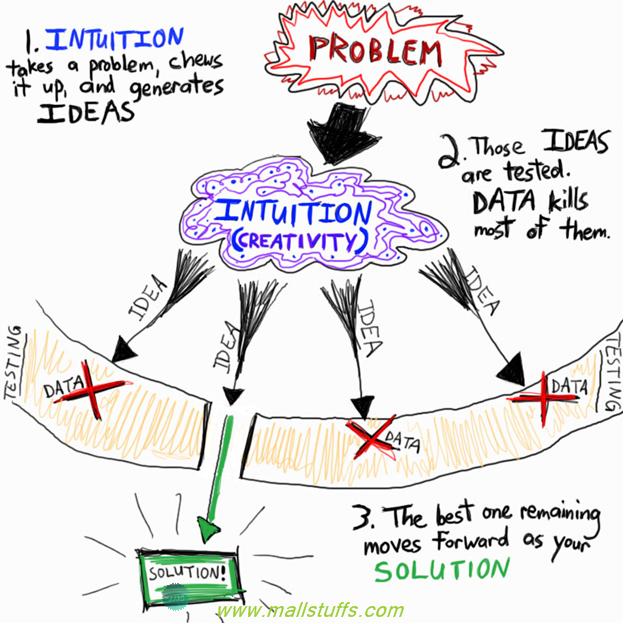
There are four factors behind gaining knowledge, instinct, reason, intuition and Brahma-Jnana(super-intuition). Instinct is found in all animals and birds but in birds and most of the animals, instinct does not interfere with the divine nature of this universe. Compared to human beings, instinct in birds & animals are more perfect since their activities do not harm the universe. Birds also have excellent instinct which is reflected in the activities of building nests, recognizing incoming disasters etc.
“Inspiration, revelation, insight, intuition, ecstasy, divine sight and supreme bliss are the seven planes of knowledge. The vast majority of people will always want something concrete to hold on to, something around which, as it were, to place their ideas, something which will be the centre of all thought-forms in their minds. This is the very nature of the mind” (Mind and Its Mysteries: p. 82).
Compensatory Advantage in Sense Perception
Indriya(Senses) differ from person to person. Some persons have acute sense of hearing while some have acute sense of sight. Many times, Indriyas(senses) are evolved and if a particular sense is defective, nature compensate it by evolving other senses. For Ex: blind person develop acute sense of hearing and touch For Ex: there is a YouTube video where a blind person can visualize the color by just touching the object. Person defected by jaundice or cataract have the defective vision, yet through their mind, they are able to perceive the exact shape and color of the object.
Speech or sound is second eyesight of a man. When you hear a particular sound, you can realize a situation in a mind. When you hear bow bow, then a picture of a dog barking on the sound comes to your mind.
How Brahman (Yogi) Perceives
There is no need of fleshy eye to see god. When a devotee closes his eyes, the picture of the god automatically comes to his mind. There is a direct connection between a devotee soul and god but since the mind is in between, this interaction is sometimes flawed. Unless you control your mind, you will be trapped into materialistic pleasures and can never realize god.
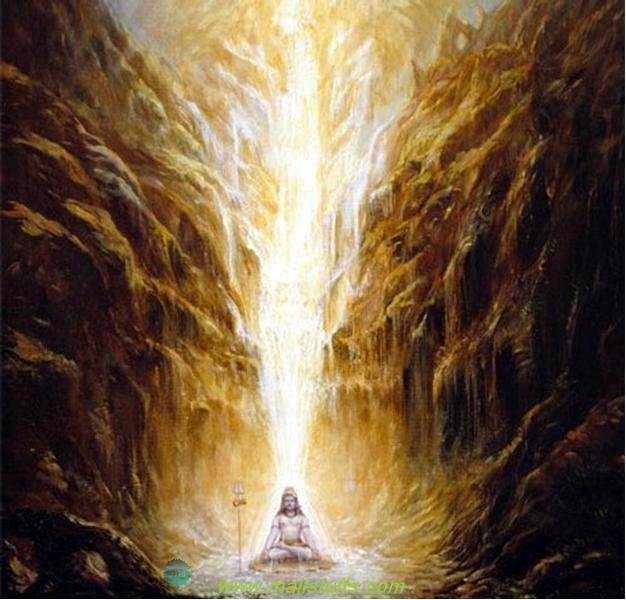
Brahman connection with god
Once again, I would like to give emphasis to the point that “it is our mind that decides what you see”. So, unless you enlighten your mind to see god, you cannot see god. Let me give you a simple example to explain this:
Suppose you see a distant object from a naked eye, you see the object unclear or blurred. This particular object has attracted your mind and now you are very interested in knowing what the object exactly is. So, you will try every possible medium and will give your full dedication and focus in your task of perceiving the object clearly. You will go near to the object, will ask somebody to get info on that object or will use some devices like binoculars, telescope etc to view the object clearly. The same thing applies to our perception of god. Only strong dedication and devotion in mind can give you perception of god. Otherwise, all your life you will believe in what your eyes see and not on what your enlightened mind can see.
Below verse from Upanishad mans the same
"I was absent-minded; I did not hear. I was absent-minded; I did not see. It is thus evident that a person sees with the mind, hears with the mind. Desire, determination, uncertainty, belief, disbelief, steadiness, unsteadiness, shame, intellect, fear-all these are in the mind alone. Therefore, when touched from behind, a person knows by the mind. (Brihadaranyaka Upanishad, I-v-3)
Conclusion
This is just a short introduction to the various theory of perception mentioned in Indian scriptures. All of these theories match with the modern science. Actually, the description is very vast and uses lot of Sanskrit words & jargons. If you are interested in knowing more on theory of perception according to Indian scriptures, then please read “Mind and its mysteries” and “Practice of yoga”. Beside these books, there are many books available in internet which will give you a concise description on theory of perception mentioned in Vedas and other spiritual scriptures.